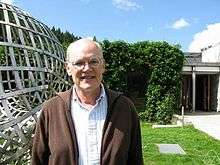Jerrold E. Marsden
| Jerrold E. Marsden | |
|---|---|
 Jerrold Marsden at Oberwolfach in 2008 | |
| Born |
August 17, 1942 Ocean Falls, British Columbia, Canada |
| Died |
September 21, 2010 (aged 68) Pasadena, California, United States |
| Nationality | Canadian |
| Alma mater |
University of Toronto Princeton University |
| Known for | Classical mechanics |
| Scientific career | |
| Fields |
Mathematics Classical mechanics |
| Institutions |
University of California, Berkeley California Institute of Technology |
| Doctoral advisor | Arthur Wightman |
| Doctoral students |
Graciela Chichilnisky Tudor Ratiu |
Jerrold Eldon Marsden (August 17, 1942 – September 21, 2010) was a mathematician. He was the Carl F. Braun Professor of Engineering and Control & Dynamical Systems at the California Institute of Technology.[1] Marsden is listed as an ISI highly cited researcher.[2]
Career
Marsden earned his B.Sc. in Mathematics at the University of Toronto and his Ph.D. at Princeton University in 1968. Thereafter, he worked at various universities and research institutes in the USA, Canada, the United Kingdom, France and Germany. He was one of the founders of the Fields Institute in Toronto, Canada, and directed it until 1994. At the California Institute of Technology he was the Carl F. Braun Professor of Engineering and Control & Dynamical Systems.[1]
Marsden, together with Alan Weinstein, was one of the world leading authorities in mathematical and theoretical classical mechanics. He has laid much of the foundation for symplectic topology. The Marsden-Weinstein quotient is named after him.
In 1981, Marsden won the Jeffery-Williams Prize. And in 1990, he received the Norbert Wiener Prize in Applied Mathematics, jointly awarded by the Society for Industrial and Applied Mathematics (SIAM) and the American Mathematical Society (AMS). Marsden was honoured "for his outstanding contributions to the study of differential equations in mechanics: he proved the existence of chaos in specific classical differential equations; his work on the momentum map, from abstract foundations to detailed applications, has had great impact."[3] He was also awarded the Max Planck Research Award for Mathematics and Computer science in 2000.[4] In 2005, he won the prestigious John von Neumann Lecture,[5] which is awarded by SIAM to recognize outstanding contributions to the field of applied mathematical sciences and for their effective communication to the community. In 2006 he was elected Fellow of the Royal Society.[6] In the same year, he also received an honorary doctorate from the University of Surrey.[7]
Books
- Jerrold E. Marsden and Alan Weinstein, Calculus Unlimited, Benjamin/Cummings (1981).[8]
- J. E. Marsden and A. Weinstein, Calculus, I, II, III', 2nd ed., Springer-Verlag (1985).[9][10][11]
- J. E. Marsden, A. Tromba, and A. Weinstein, Basic Multivariable Calculus, Springer-Verlag (1992).
- J. E. Marsden and A. Tromba, Vector Calculus, 5th ed., W. H. Freeman (2003).
- J. E. Marsden and M. Hoffman, Elementary Classical Analysis, 2nd ed., W. H. Freeman (1993)
- J. E. Marsden and M. Hoffman, Basic Complex Analysis, 3rd ed., W. H. Freeman (1998).
- Alexandre Chorin and Jerrold E. Marsden, A Mathematical Introduction to Fluid Mechanics, 3rd ed., Springer-Verlag (1993).
- J. E. Marsden, Applications of Global Analysis in Mathematical Physics, Lecture Note Series, UC Berkeley Mathematics (1976).[12]
- J. E. Marsden and M. McCracken, The Hopf Bifurcation and Its Applications, Applied Mathematical Sciences, 19 Springer-Verlag (1976).[13]
- Ralph Abraham and Jerrold E. Marsden, Foundations of Mechanics, 2nd ed., Addison–Wesley (1987).[14]
- Ralph Abraham, Jerrold E. Marsden, and Tudor S. Ratiu, Manifolds, Tensor Analysis, and Applications, Springer-Verlag (1988).
- J. E. Marsden, Lectures on Mechanics, Cambridge University Press (1992). 1st edition, 1989.[15][16]
- Jerrold E. Marsden and Thomas J.R. Hughes, Mathematical Foundations of Elasticity, Prentice Hall (1983); Reprinted by Dover Publications (1994).[17]
- J. E. Marsden and T. S. Ratiu, Introduction to Mechanics and Symmetry, Texts in Applied Mathematics, vol. 17, Springer-Verlag (1994).[18]
- J. E. Marsden, G. Misiolek, J.-P. Ortega, M. Perlmutter, and T. S. Ratiu, Hamiltonian Reduction by Stages, Springer-Verlag (2007).
References
- 1 2 "Jerrold Marsden: Mathematician at Caltech". Los Angeles Times: AA6. October 13, 2010 .
- ↑ Thomson ISI. "Marsden, Jerrold E., ISI Highly Cited Researchers". Retrieved 2009-06-20.
- ↑ "Norbert Wiener Prize in Applied Mathematics". American Mathematical Society. Retrieved 2009-11-02.
- ↑ Max Planck Society: Award winners 2000. URL last accessed 2007-08-24.
- ↑ The John von Neumann Lecture, Society for Industrial and Applied Mathematics http://www.siam.org/prizes/sponsored/vonneumann.php
- ↑ Royal Society: . URL last accessed 2010-10-02.
- ↑ University of Surrey: Doctor of the University Archived 2011-07-16 at the Wayback Machine.. URL last accessed 2008-10-17.
- ↑ Marsden, Jerrold; Weinstein, Alan J. (1981). Calculus Unlimited.
- ↑ Marsden, Jerrold E.; Weinstein, Alan J. (1985). Calculus I.
- ↑ Marsden, Jerrold E.; Weinstein, Alan J. (1985). Calculus II.
- ↑ Marsden, Jerrold E.; Weinstein, Alan J. (1985). Calculus III.
- ↑ Marsden, Jerrold E. (1974). Applications of Global Analysis in Mathematical Physics.
- ↑ Marsden, J. E.; McCracken, M. (1976). The Hopf Bifurcation and Its Applications.
- ↑ Abraham, Ralph; Marsden, Jerrold E. (1987). Foundations of Mechanics, Second Edition.
- ↑ Marsden, Jerrold E. (1992). Lectures on Mechanics.
- ↑ Atiyah, Michael (1994). "Review: Lectures on mechanics by Jerrold Marsden" (PDF). Bull. Amer. Math. Soc. (N.S.). 30 (2): 234–237. doi:10.1090/s0273-0979-1994-00470-7.
- ↑ Marsden, Jerrold; Hughes, Thomas J. R. (1983). Mathematical Foundations of Elasticity.
- ↑ Ashbaugh, Mark S. (1996). "Review of Introduction to mechanics and symmetry: A basic exposition of classical mechanical systems by Jerrold Marsden and Tudor S. Ratiu" (PDF). Bull. Amer. Math. Soc. (N.S.). 33 (3): 351–353. doi:10.1090/s0273-0979-96-00671-4.